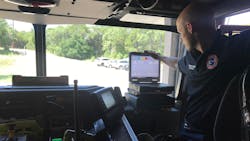TX Fire Department Evolves Its Emergency Responses
With more than half a century under its belt, the CE-Bar Fire Department is transforming the way it responds to emergency situations from fires to paramedic emergencies to active shooter situations.
Though officially known as Travis County Emergency Services District 10, the department still bears the name of its original founders, CE-Bar, an acronym for ranch owners Charles and Edna Duffy and their daughter Barbara. The agency covers 10 square miles of western Travis County, including the neighborhoods of Cuernavaca, River Hills and Lake Pointe.
Fire Chief Buddy Crain, who was the station's first full-time hire in 1996 after it switched from being a volunteer crew, says the organization has seen a lot of changes over the decades with the largest being the evolution to an emergency medical service unit along with a fire department.
Responding to about 600 calls a year, Crain said about 70% of the volume is for EMS situations — usually following car wrecks.
"Our main call volume behind false alarms is traffic collisions," Crain said. "We run a lot of those. With more development happening west, we have more people traveling through our district Most of the time (the crashes) are slip and bumps, and people are shaken not stirred. But we've had some bad ones."
As a result, the fire department is working to add paramedics on the engine to perform first response services while waiting for a ground or air unit to arrive. Crain said the goal is to have six paramedics — two for each shift.
Active shooter training and response to mental health training has also become part of the job.
About four years ago, the department bought bullet-resistant vests and tactical helmets for an active shooter situation. While the department has not responded to such a call yet, Crain said as first responders they have to be ready for anything, adding that the firefighters would go in after law enforcement has secured the scene.
"We just try to be as ready as we can to do whatever is required and pray that it never happens," Crain said.
Crain, who worked as a clinical psychologist in hospitals before becoming a firefighter, said mental health training has proven helpful as a fire chief not only when assisting patients but when dealing with his crew. He said making the station feel home-like and comfortable is a key factor in creating a healthy work environment.
He runs 48-96 schedules—48 hours on shift and 96 hours off—which he said helps with physical and mental fatigue.
The station makes room for four on-shift firefighters, each with their own bed and personalized decor, Crain said. While monitoring calls throughout the day, the on-shift crew divides their time between training, working out and enjoying family time in the living quarters. Dogs are frequent visitors to the station.
While the mood tends to be lighthearted with frequent teasing among the firefighters, Crain said his crew take their responsibility seriously.
On Friday, as the temperature climbed toward the century mark, Lieutenant Brandon Burns and firefighter Derik Harding both performed highrise training by carrying 140 pounds of equipment while climbing several flights of stairs on a stairmaster in the department garage. Burns said it's ideal to do the training in the cooler months, but sometimes it has to be done in the heat of the summer and drenched in sweat.
In the evening, the crew often works out together — after which they take turns soaking in a metal trough filled with ice water — and shares a meal.
Crain said the station keeps low lighting and low radio tones through the overnight hours. Being jerked awake to a radio call can be shocking and is bad for the body and mental health, he said.
Using a pit crew model, each on-shift firefighter is assigned a position on the truck. Jackets, boots and other equipment are often placed near their assigned seats so in the event of a call they can jump into their gear quickly. Each member has to be fully dressed before getting on the truck. A GPS system on board details the situation and location.
Crain said the department can usually respond within four to six minutes of a call. Following an intense call, Crain said the crew is required to go through a mental health debriefing.
"We go out and deal with some horrible stuff," Crain said. "We see, touch and smell stuff that normal people don't. We have arranged contracts with healthcare providers to help our guys deal with the more intense things. We all have our ghosts, and you gotta deal with it and put things in perspective because otherwise you seek things that numb that such as alcohol and drugs."
Aside from acting as a first responder during emergencies, Crain said the department's other goal is making more resources available to the community.
"We've talked about what can we do to serve people out there that don't need an ambulance and it's not necessarily an emergency," Crain said, "such as blood pressure checks, post-hospital release visits or something where we can get out and do more community prevention services."
In addition, Crain said the department is also working on providing CPR and first-aid classes to the community.
"Anytime you can increase the proficiency and knowledge base you're ahead," Crain said. "Everybody wins and it gives you the opportunity to be empowered. Saving someone's life is absolutely the coolest thing you can do."
———
©2019 Austin American-Statesman, Texas
Visit Austin American-Statesman, Texas at www.statesman.com
Distributed by Tribune Content Agency, LLC.
